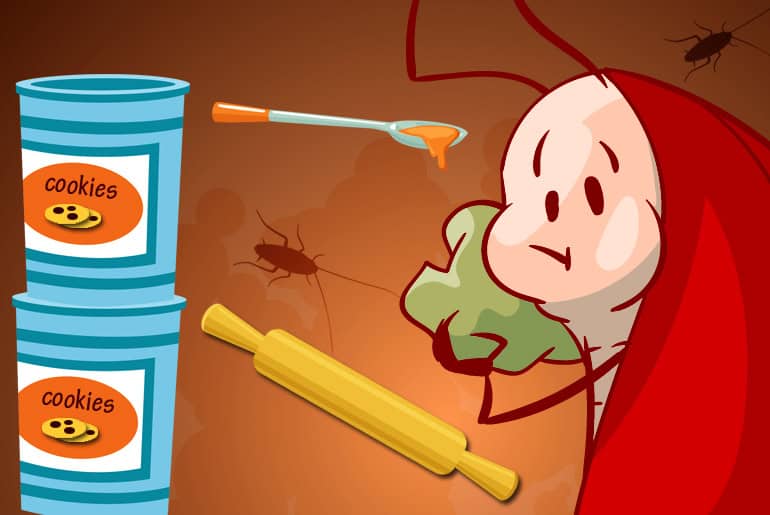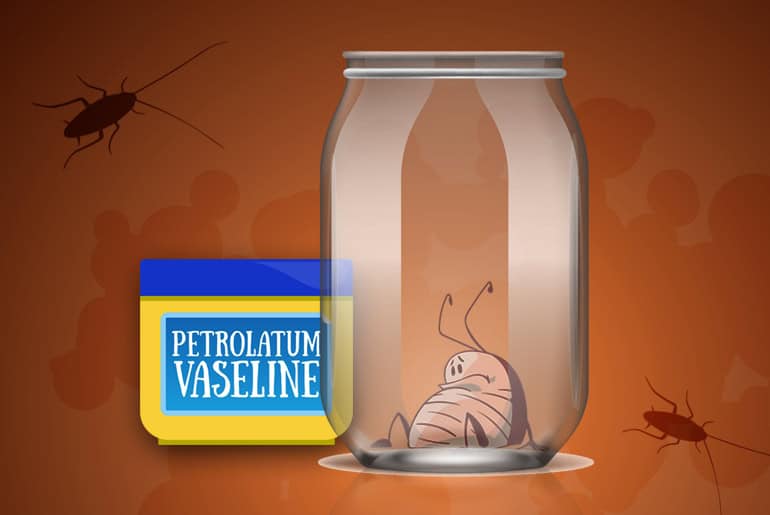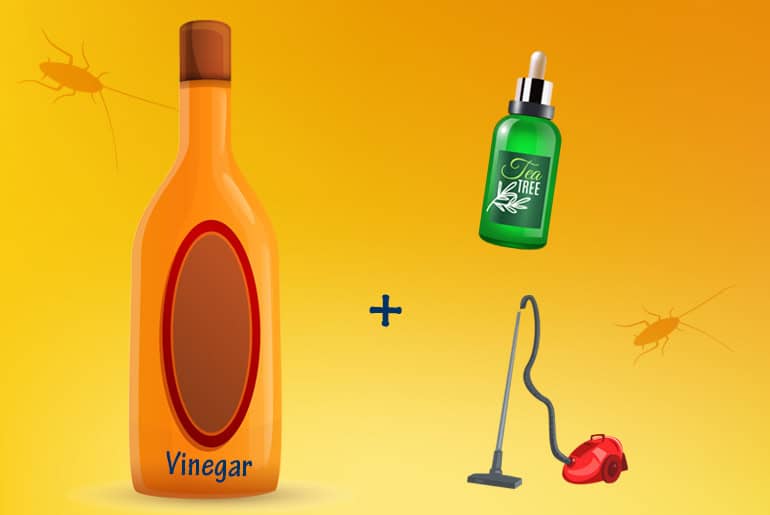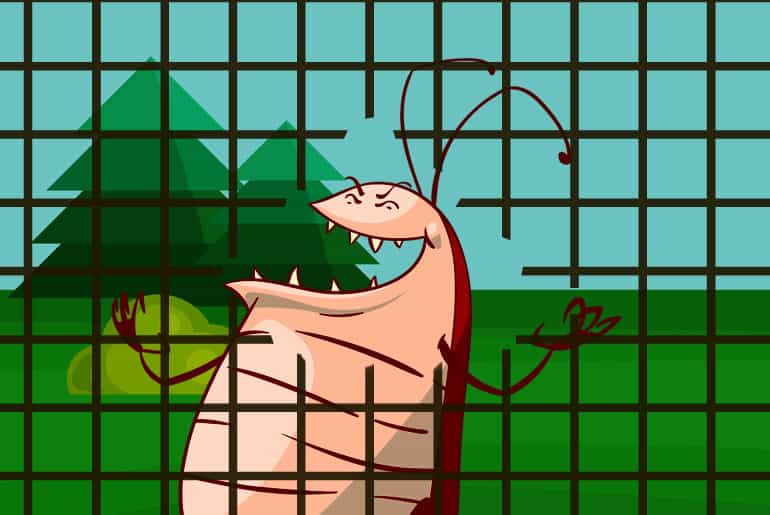The worst part of your cockroach nightmare is waiting for it to end. You’ve seen them crawling around, you’ve caught them eating your food and you just want them gone.
How long do cockroaches live? As long as you let them.
We’re going to explore the cockroach lifespan from birth to death, explain what can shorten it and show you how to stop waiting and start getting rid of roaches today.
Ready? Let’s go!
The Roach Lifespan: From Egg to End
Early Life

The cockroach begins its life as a minuscule egg, one of as many as fifty held inside an egg case, called an ootheca. The female cockroach carries its egg case for 1 to 2 months until shortly before the eggs hatch. Then, it attaches the ootheca to a well-hidden surface.
Growing Up

The baby cockroach—called a nymph—goes through as many as 10 instars on its way to adulthood. During each of these phases, it sheds its exoskeleton and begins to grow a larger one. A newly molted nymph might appear translucent white before its brown or black exoskeleton develops anew.
All of this occurs over a period of months, which varies from species to species.
- German cockroaches mature in about 2 months.
- American cockroaches take about 600 days to reach adulthood.
During its final, “young adult” stage, the cockroach nymph looks much like its parents. This is also where it earns—er, grows—its wings if it’s going to have any. By this point, it’s ready to join in with the adults… terrorizing homes.
Adulthood

As soon as it reaches adulthood, the cockroach is ready to mate and reproduce. It’s also in the prime of its life, doing the maximum amount of exploring and scavenging for food anywhere it can—dumpsters, sewers, warehouses, bathrooms and kitchens.
A Day in the Adult Cockroach’s Life
An adult cockroach has 3 jobs:
- Hide. Roaches spend most of their time in hiding. Even fully-grown roaches can squeeze into coin-sized crevices and holes the width of a pen. Because they’re so good at hiding, it’s tricky to guess how many there really are. One or two roaches out in the open might mean dozens or hundreds hiding in the walls or beneath the floor.
- Eat. If a cockroach isn’t hiding it’s probably out looking for food. Roaches are primarily nocturnal and do most of their scavenging in the dark. They need very little food to survive but search daily for it, and eat just about anything, including paper, book bindings, fingernails, and hair.
- Breed. Finally, cockroaches are prolific breeders. Remember the ootheca with 50 eggs in it? Well, one female can produce 8 or more of these egg cases—a lifetime total of 300-400 offspring!
What All That Activity Means for You
For roaches, that daily grind is simply what cockroaches do. For you however, it can mean trouble.
Those sewer trips and sneaky dumpster runs leave bacteria, viruses, fungi, and protozoa clinging to their bodies. Then when they show up back at your place to eat your food, they deposit it on your shelves, your drawers, and in your food itself.
And then there are the droppings!
Cockroach droppings are yet another way roaches bring dangerous bacteria into your home. All those tiny black specks you’ve noticed lately? They’re cockroach feces. And along with all the egg casings roaches leave behind, they can trigger allergic reactions and asthma attacks, too.
How Long Do Roaches Live; Or, WHEN DO THEY DIE?

Not soon enough…
The average lifespan of a cockroach is about 1.5 years.
But their lifespan depends heavily on food and water availability, climate and habitat. Some roaches freeze. Others fall into the mouths of predators. Most cockroaches die of dehydration or starvation.
What if you could take advantage of that weakness? What if you could get rid of cockroaches by taking away their food and water?
How long can a cockroach live without food and water?
These bugs can live up to a month without eating! That’s a bad sign for the starvation system.
However, they’re extremely sensitive to dehydration: a cockroach can’t survive longer than a week without water. Even a few parched days can make a roach too sluggish to get by.
When you take away their food and water, a cockroach immediately begins shedding weight.2 Its cells die at a higher rate. Mitosis—cell division—slows by up to 50% as part of the insect’s natural response to a lack of food and water. You’re winning!
Of course, you wouldn’t see this happening. Here’s what you would see:
- Reduced cockroach activity: Without adequate food and water, cockroaches become weak and lethargic. They’ll stop scurrying around as much. If you were seeing a lot of roaches, you’ll notice a big difference within a few days. The change in a small infestation will be harder to notice but, after a couple of weeks, you’ll hardly see any living roaches.2
- Dead cockroaches: A few roaches might kick the bucket on the floor or behind an appliance but most will die in their nest, out of sight and out of reach.
So, is it possible to starve roaches out?
If this sounds like a solution to your pest problem, remember that cockroaches eat almost anything. These insects have survived for over 300 million years because of their ability to scavenge food and find water almost anywhere.
Unless you’re sleeping in a lab, it’s practically impossible to starve them out. You’d have to eliminate every crumb, scrap of garbage and drop of water. And you’d have to keep it up for a month or longer!
Then there’s the problem of roach eggs—your sanitation won’t have any effect on the baby roaches already waiting to hatch in the walls or crawl spaces. They’ll grow up just when you think you’ve won and emerge as an even larger second wave facing an exasperated, exhausted enemy force.
Finally, there’s no way to know if you’re winning. You might not see any dead roaches, even if your plan is working.
It’s simply not worth the work, not when there’s a better, more powerful, proven and provable system at your disposal.
A state-of-the-art, professionally-inspired pest control system.
How long can cockroaches withstand an all-out attack?

We’re going to eliminate cockroaches using 4 state-of-the-art tools:
- Bait
- Traps
- Dust
- IGR
But it all begins with sanitation. Along with thorough cleaning, scrubbing and vacuuming, exclusion plays a vital role in eliminating roaches. You want to make sure they can’t find anywhere to get comfortable or, more importantly, lay their eggs.
Exclusion involves sealing up every potential entry point, crack and crevice that would allow roaches to enter and escape. That way, new ones can’t find any way to enter your home and existing ones can’t escape the doom you’ve laid out for them.
What happens when you clean, seal and organize?
Immediately, roaches will have to change their habits. Their normal food sources are gone, their pathways are cut off and they’re looking for new places to breed. Without easy access to water, they’ll start dying within the first week.
Now that they’re weakened, it’s time to roll out your cannons.
Baiting Roaches

Your main weapon against cockroach infestations is gel bait, or a set of bait stations.
When there’s no easy food around, the smell of gel bait becomes irresistible to hungry roaches.
It’s going to look like you’ve attracted even more roaches but those are simply the ones that were hiding.
It means the baits are working. You might even observe roaches limping out into the open to die. Baits will start to kill roaches within 1-3 days. Some infestations could be completely eradicated within 2 weeks.
Learn all about choosing and using roach bait.
Trapping Roaches

Traps like insect monitors, roach motels, or sticky traps catch lots of roaches on their own. They’re baited with a food scent that will drive starving roaches crazy. Good traps can kill roaches overnight but eliminating an infestation takes longer.
Read up on 15 of the best roach traps.
Dusting for Roaches

A strategic sprinkling of insecticidal dust in the places where your traps caught the most cockroaches will kill any that managed to escape.
Anywhere roaches travel, sprinkle CimeXa, boric acid or another deadly dust that will stick to their legs.
The insecticide poisons the cockroach while it grooms itself. A cockroach won’t survive longer than a day after walking through the dust.
Get our step-by-step guide to using insecticidal dust.
IGR to stop reproduction

An insect growth regulator (IGR) prevents cockroach nymphs from reaching full maturity (and in some cases, prevents eggs from hatching). Any nymphs that absorb the IGR will have their growth stunted and their strength weakened.
More importantly, these roaches can’t have babies. While your other control methods kill as many adult roaches as possible, an IGR ensures that any that survive (for the time being) aren’t able to lay any egg cases to surprise you later.
IGR-affected roaches probably won’t survive more than a few weeks. These weakened insects will bumble around until they fall prey to a trap, bait or dust that’s left after the initial extermination.
Conclusion
How long do cockroaches live? Left to their own devices, they’ll survive about a year.
But there’s one factor that can affect the cockroach lifespan more than anything else: you.
If you heed the advice above and follow our comprehensive guide to killing cockroaches, you could be enjoying a roach-free home this time next month.
Be patient. Be determined. Be brave.
You can do this!
Frequently Asked Questions
From hatching to death, the German cockroach lifespan is only about 100 days. But these bugs are the worst of the worst. During that short time, one female can produce hundreds of offspring. Their population growth is exponential.
The American cockroach is one of the hardier roach species, with a lifespan from hatchling to death of 2 years or more. Females produce an average of 150 young over their lifetimes.
The Oriental cockroach lives for up to 2 years but its adult lifespan is just 6 months under ideal conditions.
any cockroaches don’t survive well in cold environments (finally, some good news). For example, the German cockroach struggles to live through cold winters in homes that lack central heating.
The lifespan of a cockroach decreases drastically in a cold environment. It also reproduces less frequently in the cold.
Roaches won’t survive 24 hours in a freezer. Sub-freezing temperatures kill these resilient pests after just a day of exposure, effectively shocking their cold-blooded bodies.
Obviously, you can’t plunge your whole house into subzero temperatures! But if you’ve got a couch or other piece of furniture that’s infested, placing it for a few days in a garage or shed where it’s below zero will kill the bugs inside.
In a total vacuum, most cockroaches will be dead in minutes (though some can go for as long as 45 minutes). If you’ve found cockroaches in your clothes and thought about sealing them in a vacuum storage bag overnight, the results might disappoint—a normal vacuum won’t remove all of the air.
They won’t suffocate, but so long as there’s no moist food inside, they will die of dehydration in a week or so!
Pro tip: While you have the vacuum out, use it to suck up every roach you can find—dead or alive. Then empty the chamber or discard the vacuum bag into a sturdy garbage bag you can seal. Freeze it overnight or place it immediately in the dumpster, far from your home.
After a professional exterminator has sprayed, fumigated and baited your home, how long do you have to wait until the roaches are finally gone?
If you’re lucky, you’ll see noticeable results within 3 days of the treatment. In most cases, you’ll start seeing fewer roaches after 1 to 2 weeks. After a month, all but the most severe infestations should be dead and gone.
Written by Andrew Martin. Reviewed by Rae Osborn, PhD.

Andrew Martin
Writer/Publisher
Andrew writes for, and along with his daughter, publishes Cockroach Facts. You can read more about him here.

Rae Osborn, PhD.
Science Editor
Dr. Rae Osborn holds Honors Bachelor of Science degrees in Zoology and Entomology, and a Master of Science in Entomology from the University of Natal in South Africa. She holds a PhD in Quantitative Biology from the University of Texas at Arlington, where her research was in Entomology. You can learn more about our contributors here.
Sources
- German Cockroach: Biology, Identification, Control. (2013) North Carolina State Extension. Retrieved from https://entomology.ces.ncsu.edu/german-cockroach/
- Reynierse, James H. et al. (1972) The Effects of Hunger and Thirst on Body Weight and Activity in the Cockroach (Nauphoeta Cinerea). Animal Behavior.
- Park, Moon Soo and Mario Takeda (2007) Starvation suppresses cell proliferation that rebounds after refeeding in the midgut of the American cockroach, Periplaneta americana. Journal of Insect Physiology. Retrieved from https://doi.org/10.1016/j.jinsphys.2007.10.011
- Park, Moon Soo, et al. (2009) Starvation induces apoptosis in the midgut nidi of Periplaneta americana: a histochemical and ultrastructural study. Cell and Tissue Resesarch. Retrieved from https://doi.org/10.1007/s00441–008–0737-y
- Valles, Steven (2017) German cockroach. University of Florida Department of Agriculture and Consumer Services. Retrieved from http://entnemdept.ufl.edu/creatures/urban/roaches/german.htm
- Omg, Barb, et al. (2006) Cockroach Control Manual. University of Nebraska Extension.
- How Long Can Cockroaches Live Without Food? (2019) PFHarris. Retrieved from https://pfharris.com/how-long-can-cockroaches-live-without-food/
- Hahn, Jeffrey (2018) Cockroaches. University of Minnesota Extension. Retrieved from https://extension.umn.edu/insects-infest-homes/cockroaches#pennsylvania-wood-cockroach-137714
- Wilson, Tracy V. V. How Cockroaches Work. HowStuffWorks. Retrieved from https://animals.howstuffworks.com/insects/cockroach2.htm























































